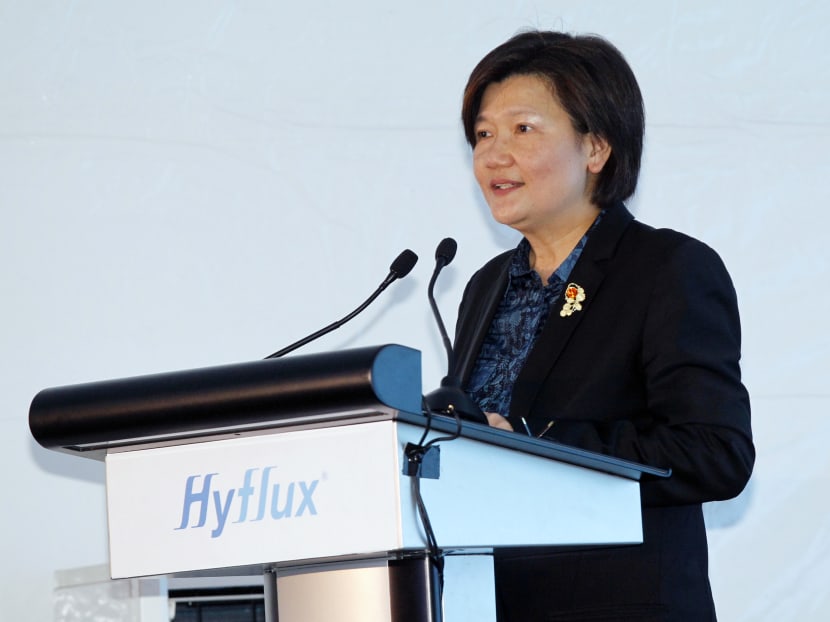CEO Olivia Lum did not get S$60m in dividends in 2017, says Hyflux
SINGAPORE — Beleaguered water treatment plant Hyflux has responded to a series of questions from Singapore’s investor watchdog, refuting claims that its founder Olivia Lum received more than S$60 million in dividends in the year her company’s shareholders and bondholders saw their entire investments destroyed.

Hyflux founder Olivia Lum speaking at the opening ceremony of Singapore's second and largest desalination plant, Tuaspring Desalination Plant.
SINGAPORE — Beleaguered water treatment plant Hyflux has responded to a series of questions from Singapore’s investor watchdog, refuting claims that its founder Olivia Lum received more than S$60 million in dividends in the year her company’s shareholders and bondholders saw their entire investments destroyed.
On Monday (Feb 11), the Securities Investors Association Singapore (SIAS) had posed more than 40 questions in a letter to Hyflux.
Once seen as the darling of Singapore’s entrepreneurial scene, the firm is now undergoing a court-supervised reorganisation after chalking up a debt of S$2.95 billion as of March 31, 2018.
In Ms Lum’s letter to SIAS sent on behalf of the Board, Hyflux’s executive chairman and group chief executive officer said that they are “deeply saddened and disappointed” that the firm “did not succeed in the manner we had intended and the company now finds itself in its current state”.
Hyflux’s email reply to the SIAS in an 18-page document was published on Friday to address each of the watchdog’s questions.
Here are some of Hyflux's responses to key concerns SIAS had highlighted in its letter.
SIAS said Ms Lum received over S$60 million in dividends from her 34 per cent shareholding in Hyflux in 2017, when Hyflux reported losses of S$115.6 million.
Hyflux clarified that Ms Lum did not receive any cash dividends for the financial year of 2017.
Instead, for the period of 2007 to 2016, she received about S$58 million in proportional cash dividends, which were declared and paid to shareholders.
During that period, Hyflux recorded a cumulative profit after tax and minority interest of S$527 million and total ordinary shareholders dividends of S$186 million.
Q: Why is Ms Lum not contributing her gains to the restructuring process?
Hyflux said that Ms Lum’s personal net worth is “tied inextricably” to her stake in Hyflux as she has not sold any of her shares since 2006 and will “suffer a significant loss”.
As a result of the company’s restructuring, her current equity stake is diluted substantially “on the same terms” as all other stakeholders.
In addition, she will lose her controlling position in the company.
Hyflux said Ms Lum has volunteered to “relinquish all rights” to any management retention shares that would otherwise be awarded to her as a result of the restructuring process.
Ms Lum is continuing to find ways to “enhance the recovery” for the perpetual securities and preference shareholders, said the company.
Q: Will Ms Lum continue to have a role in the company after it is restructured?
Hyflux says she is willing to take on any role in the company following its restructuring. However, this will be subject to discussions with SM Investments.
The investment firm, which is made up of Salim Group and Medco Group, plans to acquire 60 per cent of Hyflux for S$400 million and grant a shareholder's loan of S$130 million.
Q: Were bondholders and shareholders informed that Hyflux had been generating negative operating cash flow every year since 2009? If so, in what form?
Hyflux said its financial metrics have been publicly disclosed on a quarterly basis and are available to all bondholders and shareholders.
Being a Singapore Exchange-listed company, its financial statements — including cash flow statements — are also released on a quarterly basis and can be found on the company’s website, its annual reports and the SGX website.
These financial statements were also included in the prospectuses for the perpetual securities and preference shares, added the firm.
Q: Why did the Board continue to pay dividends when the operating cash flow was negative and accumulating more debt during this time?
Hyflux’s dividends are declared and paid out of its retained earnings, the company said.
These “significant retained earnings” came from record net profits prior to 2017, which allowed it to declare dividends on an annual basis, it said.
It was not until 2017 that Hyflux said it recorded a net loss and consequently no cash dividends were declared for that year.
Q: How was it possible that despite negative operating cash flow, Hyflux continued to report profits in each year prior to 2017?
The company’s profits are largely derived from engineering, procurement and construction (EPC) activities, operations and maintenance (O&M) and divestment gains, it said.
Its cash flow is a separate financial metric which sets out cash outflows and inflows over a specific period of time and does not necessarily correlate with profit and loss in the same period.
Hyflux added that consistent with its business model, it recorded negative operating cash flow due to its large infrastructure projects such as Tuaspring, Qurayyat and TuasOne.
Q: The Tuaspring plant was partly funded by a shareholder loan of S$57 million. How was this loan from Hyflux to Tuaspring funded?
Hyflux clarified that the amount it funded to Tuaspring via shareholder loans was an aggregate total of S$982 million as of Dec 31, 2016.
Tuaspring was funded through a combination of non-recourse project financing debt, shareholder loans and equity from it.
It added that its shareholder loans and equity to Tuaspring were funded from proceeds of issuance of the S$400 million preference shares raised in 2011.
Other sources of funds came from the S$500 million perpetual securities raised in 2016, which replaced earlier repayment of notes and redemption of perpetual securities and other corporate debt of Hyflux.
Q: Why did the Board not consider it prudent to either write down or impair Tuaspring since it was loss making from the commencement of operation in 2015?
Hyflux said that despite the losses, the long term view by industry experts was that the Singapore power market would recover.
It said that when the Tuaspring project was first awarded in 2011, the Singapore power market was “very favourable”.
However, an oversupply of gas in the market lowered demand for electricity generation.
To illustrate its point, Hyflux said the average wholesale electricity price dropped from about S$220 per MWh in 2011 to an average of S$81 per MWh in 2017. This resulted in “significant losses from electricity generation”, it added.
An independent expert valuation of the project was also commissioned when Tuaspring commenced operation in 2016. This report supported the book value of the project.
During Tuaspring’s divestment process in 2017, the company said it received three preliminary non-binding bids that similarly supported the book value of the project.
Accordingly, Hyflux said the Board did not see a reason to impair the book value of Tuaspring.
Q: What is the basis of valuing Tuaspring at S$1.4 billion?
Based on the financial model which shaped cash flow projections from Tuaspring, Hyflux said the project was expected to generate profits from day one.
Furthermore, the financial model was audited by an external auditor and furnished to the offtaker.
When it was able to secure a non-recourse project financing loan in 2013, Hyflux said the lender commissioned an independent market study of Tuaspring which arrived at similar conclusions to support the book value of approximately S$1.4 billion.
A second market study in 2016 by the lender corroborated the book value.
While its 2017 divestment process attracted three preliminary non-binding bids that also supported Tuaspring’s book value, its 2018 sale process during the moratorium did not yield a similar bid.
This was due to the limited number of parties pre-qualified to perform due diligence at such time.
Q: What is the monthly cash burn at Tuaspring? What are its current cash reserves? What is the current market value for the Tuaspring asset?
Based on its 2016 audited accounts, Hyflux said the project’s operating cash flow for the year was S$70 million.
However, it was unable to disclose Tuaspring’s current cash reserves, citing non-disclosure obligations owed to the offtaker of the project.
It also said there is no “ascertainable current market value” on Tuaspring as there are no third parties looking actively to acquire the asset.








